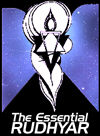 |
| Home | Bio | Art | Music | Literature | Civilization & Culture | Philosophy of Wholeness | Theosophy & Spirituality | Astrology |
 THE ESSENTIAL RUDHYAR
An outline and an evocation
by Leyla RaŽl 1983 I. FOUNDATIONS
II. CONCEPTUAL FORMULATIONS
1. The Experience of Change
2. Wholes in Time: Cycles 3. Wholes in Space: Entities 4. Wholeness 5. Holarchy & Dharma 6. Evolution & the Two-Way Cosmic Process 7. The Challenge of "Transfinite" Wholeness to Finite Wholes 8. Activity & Consciousness 9. The Principles of Unity & Multiplicity 10. The Movement of Wholeness 11. The Cycle of Being 12. Human Evolution & Reincarnation Within the Cycle of Being 13. The Constitution & Entire Cycle of Human Being 14. The Nature and Function of Mind 15. The Planetary Whole & the Place & Function of Human Evolution Within It 16. Rhythms of Culture & Civilization 17. The Process of Transformation 18. Transpersonal Activity 19. The Process of Deconditioning & Renewal
III. RUDHYAR'S
INTEGRATION OF EXPERIENCE AND CONCEPTS |

II. CONCEPTUAL FORMULATIONS
9. THE PRINCIPLES OF UNITY AND MULTIPLICITY
From the interplay of involution and evolution, consciousness and activity, subjectivity and objectivity, oneness and manyness, Rudhyar derives two principles inherent and coactive in Wholeness, the principle of Unity and the principle of Multiplicity. In Chinese philosophy they are called Yin and Yang (and Rudhyar's philosophical approach is perhaps closer in spirit to Chinese than to Hindu Metaphysics, although it includes elements from both).
Because of the principle of Unity, motion (activity) is rhythmic and cyclic (occurring in units), and existence manifests in wholes. Because of the principle of Multiplicity, existence manifests as a multitude of wholes in which ever more expansion and differentiation occurs. Because of the principle of Unity, the process of differentiation (evolution) is self-actualizing ó that is, it is guided from within by and toward the actualization of a set of inherent (involutionary) archetypal principles. By permission of Leyla Rudhyar Hill Copyright © 1983 by Leyla RaŽl All Rights Reserved.  Web design and all data, text and graphics appearing on this site are protected by US and International Copyright and are not to be reproduced, distributed, circulated, offered for sale, or given away, in any form, by any means, electronic or conventional. See Notices for full copyright statement and conditions of use. Web design copyright © 2000-2004 by Michael R. Meyer. All Rights Reserved. |
 |